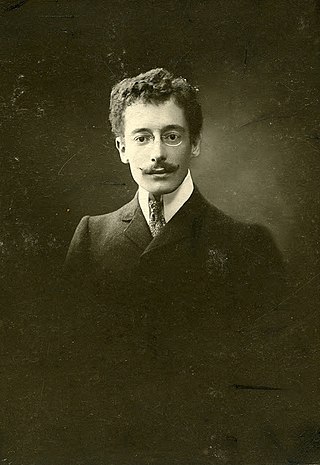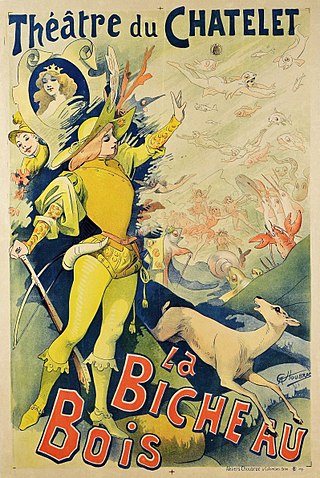This article needs additional citations for verification .(September 2018) |
Paul-Pierre Roux, called Saint-Pol-Roux (15 January 1861, quartier de Saint-Henry, Marseille - 18 October 1940, Brest) was a French Symbolist poet.
This article needs additional citations for verification .(September 2018) |
Paul-Pierre Roux, called Saint-Pol-Roux (15 January 1861, quartier de Saint-Henry, Marseille - 18 October 1940, Brest) was a French Symbolist poet.
Saint-Pol-Roux was born to a middle-class family in Marseille, where his father was an industrialist. He studied in a lycée in Lyon, and left it as Bachelor of Arts in 1880. He then wrote some plays under his own name.
He left the south of France to install himself in Paris. He particularly frequented the salon of Stéphane Mallarmé, for whom Saint-Pol-Roux had the greatest admiration. He won a certain notoriety, trying out several pseudonyms before finally becoming "Saint-Pol-Roux le magnifique". One of his plays, La Dame à la faulx, was put on by Sarah Bernhardt, and was interviewed by Jules Huret as a member of the Symbolist movement. He perhaps participated in the Rosicrucian aesthetic of Péladan. Nevertheless, he wrote nothing on the movement or on its founder although Saint-Pol-Roux seems to have been interested in this audacious literary experiment.
Saint-Pol-Roux leaves Paris in 1898, having come to hate it for his being ostracized, and for the mediocrity of the literary criticism circles, ignoring it with as much pride as he himself had been ignored. On a clairvoyant's advice, and also to escape his creditors, he left for the Ardennes. There he settled with his wife in Roscanvel, in Finistère, where their daughter Divine was born. After his father's death, he moved to Camaret and made Brittany the center for his work.
Living off the revenue he earned from his libretto for the opera Louise, he bought a house overlooking the ocean, above the Pen Had beach, on the road to pointe de Pen Hir. He transformed it into a manor in the Baroque style. He named it the ”Manoir de Coecilian”, after his son's name, or sometimes ”Manoir des Boultous”. He wrote "Facing the sea, man is closer to God" ("Face à la mer, l'homme est plus près de Dieu"). He welcomed several artists and writers at the manor, notably Louis-Ferdinand Céline, who looked up to him as an ancestor, and even Jean Moulin, then ”sous-préfet de Châteaulin”, who visited in 1930.
Saint-Pol-Roux was a member of the académie Mallarmé from 1937 to 1940.

The Crozon peninsula was occupied by German troops in the Battle of France. A drunken German soldier invaded the manor during the night of 22 to 23 June 1940. He killed the family's faithful governess Rose with several gun shots and wounded Saint-Pol-Roux's daughter Divine with a bullet. It is often said that the soldier also raped Divine, something she later refuted. Saint-Pol-Roux was wounded, but managed to survive the tragedy, as the German soldier fled, frightened by the house dog. The case greatly embarrassed the German military authorities. German military authorities arrested the culprit already on 23 June 1940. He was tried by the German court martial in Brest, sentenced to death and executed.
Divine was taken to a hospital in Brest, where she was treated until 15 April 1941. Saint-Pol-Roux was deeply affected by the death of Rose, the injuries of his daughter and the blows he had received. While commuting between the hospital in Brest and Camaret he learned that the mansion had been visited again. The mansion was looted on 3 October 1940. The various rooms of the manor, in particular its bedroom and its study, were in great disorder. Manuscripts of several works on which that Saint-Pol-Roux had been working for several years had been torn or burned.
When he saw the disaster, he understood that it would be impossible for him to reconstruct his work and felt an immense despair. Saint-Pol-Roux suffered an uremic crisis and was transported to the hospital in Brest on 13 October 1940. He died on 18 October 1940. Louis Aragon published an article on the "assassination" of Saint-Pol-Roux, as he called it. The article was called "Saint-Pol Roux, ou L'Espoir" and published in the journal Poésie a month after the death of Saint-Pol-Roux. It was the first article published by Aragon after the fall of France, and was censored by the Vichy authorities. [1]
The manor was occupied by the German military during World War II, used by the Marine Flak Abteilung 804 as a command center. The unit was dedicated to coastal anti-aircraft defense and the German army eventually installed two French Lahitolle 95 mm cannons at the gates of the manor. The manor was bombed several times by Allied airforces and eventually burned down on 11 October 1944, only seven days before the liberation of Camaret.
On the Liberation, Divine tried in vain to ensure that her father's work was not forgotten. It is in large part due to the salvage work, editing and publication of editions of his work by Rougerie during those years, which she called "purgatory", that his poems, essays and plays that had escaped Nazi barbarism were edited and re-edited anew. A considerable number of unedited manuscripts (Le Trésor de l'Homme, La Répoétique) survived the pillaging.
Saint-Pol-Roux is the archetypal "forgotten poet". It was under this title that he was a dedicatee of André Breton's Clair de Terre (also dedicated to "ceux qui comme lui s'offrent le magnifique plaisir de se faire oublier (sic)", or "those who like him offered themselves the great pleasure of making themselves forgotten"), and Vercors's Le Silence de la mer (calling him "le poète assassiné", or "the assassinated poet").
Saint-Pol-Roux attempted to create a total work of art. This dream of Symbolist literature consisted of creating a perfect work responding to all the senses. Saint-Pol-Roux himself was therefore very interested in plays and operas during his Parisian years. At the end of his life, he marvelled at the artistic possibilities offered by the cinema.
Saint-Pol-Roux equally created the notion of "idéoréalisme". He desired an artistic fusion between the real world and the world of ideas in a Neoplatonic perspective. He imagined a cosmology in which Beauty - lost in the real world - has to be revealed by the poet.
{{cite book}}: CS1 maint: location missing publisher (link)
Anne Claude de Tubières-Grimoard de Pestels de Lévis, comte de Caylus, marquis d'Esternay, baron de Bransac, was a French antiquarian, proto-archaeologist and man of letters.

Georges Duhamel was a French author, born in Paris. Duhamel trained as a doctor, and during World War I was attached to the French Army. In 1920, he published Confession de minuit, the first of a series featuring the anti-hero Salavin. In 1935, he was elected as a member of the Académie française. He was nominated for the Nobel Prize in Literature twenty-seven times. He was also the father of the musicologist and composer Antoine Duhamel.
Éditions Gallimard, formerly Éditions de la Nouvelle Revue Française (1911–1919) and Librairie Gallimard (1919–1961), is one of the leading French book publishers. In 2003, it and its subsidiaries published 1,418 titles.

Victor Segalen was a French naval doctor, ethnographer, archeologist, writer, poet, explorer, art-theorist, linguist and literary critic.

Camaret-sur-Mer is a commune in the Finistère department in northwestern France, located at the end of Crozon peninsula.
Marianne Van Hirtum was a Belgian author writing in the French language, connected with the surrealist movement.

The Battle of Camaret, also referred to as the Brest expedition, was a notable engagement of the Nine Years' War. Expecting Brest to be unguarded as the French fleet stationed there sailed south to face the Spanish, an amphibious operation at Camaret Bay was launched on 18 June 1694 by a 10,000 to 12,000-strong Anglo-Dutch force in an attempt to take and occupy the city, which represented one of the most important French naval bases. The French, however, were well aware of their plan.
Alexandre Alexandrovich Mnouchkine was a French film producer.

The Goulet de Brest is a 3-km-long strait linking the roadstead of Brest to the Atlantic Ocean. Only 1.8 km wide, the goulet is situated between the Pointe du Petit Minou and the Pointe du Portzic to the north and the îlot des Capucins and the Pointe des Espagnols to the south.
Jim Sévellec(21 January 1897 – 21 May 1971), born Eugène Sévellec, was a French painter.

Georges-Emmanuel Clancier was a French poet, novelist, and journalist. He won the Prix Goncourt (poetry), the Grand Prize of the Académie française, and the grand prize of the Société des gens de lettres.

Edmonde Charles-Roux was a French writer.
Raymond Delamarre (1890–1986) was a French sculptor and medalist. He played a major role in the Art Déco movement. While his ecclesiastical work showed the influence of Catholicism, he was personally agnostic. His art, especially his war memorials, was also influenced by his firsthand experiences of the horrors of the First World War.

Féerie, sometimes translated as "fairy play", was a French theatrical genre known for fantasy plots and spectacular visuals, including lavish scenery and mechanically worked stage effects. Féeries blended music, dancing, pantomime, and acrobatics, as well as magical transformations created by designers and stage technicians, to tell stories with clearly defined melodrama-like morality and an extensive use of supernatural elements. The genre developed in the early 19th century and became immensely popular in France throughout the nineteenth century, influencing the development of burlesque, musical comedy and film.
The following is a timeline of the history of the city of Brest, France.

Jean-Édouard Dargent, known as Yan' Dargent and in his later years Yann Dargent, was born in Saint-Servais on 15 October 1824 and died in Paris on 19 November 1899. He was a French painter and illustrator. Most of his paintings depicted Brittany.

Louis Charles du Chaffault de Besné was a French Navy officer. He notably took part in the Second Battle of Cape Finisterre in 1747, and was one of the commanders at the Battle of Ushant on 27 July 1778.He also lead the Larache expedition
Yves Grosrichard (1907-1992) was a 20th-century French journalist who led an important role in the editing press in France after the World War II.
The canton of Vallée de l'Homme is an administrative division of the Dordogne department, southwestern France. It was created at the French canton reorganisation which came into effect in March 2015. Its seat is in Montignac-Lascaux.